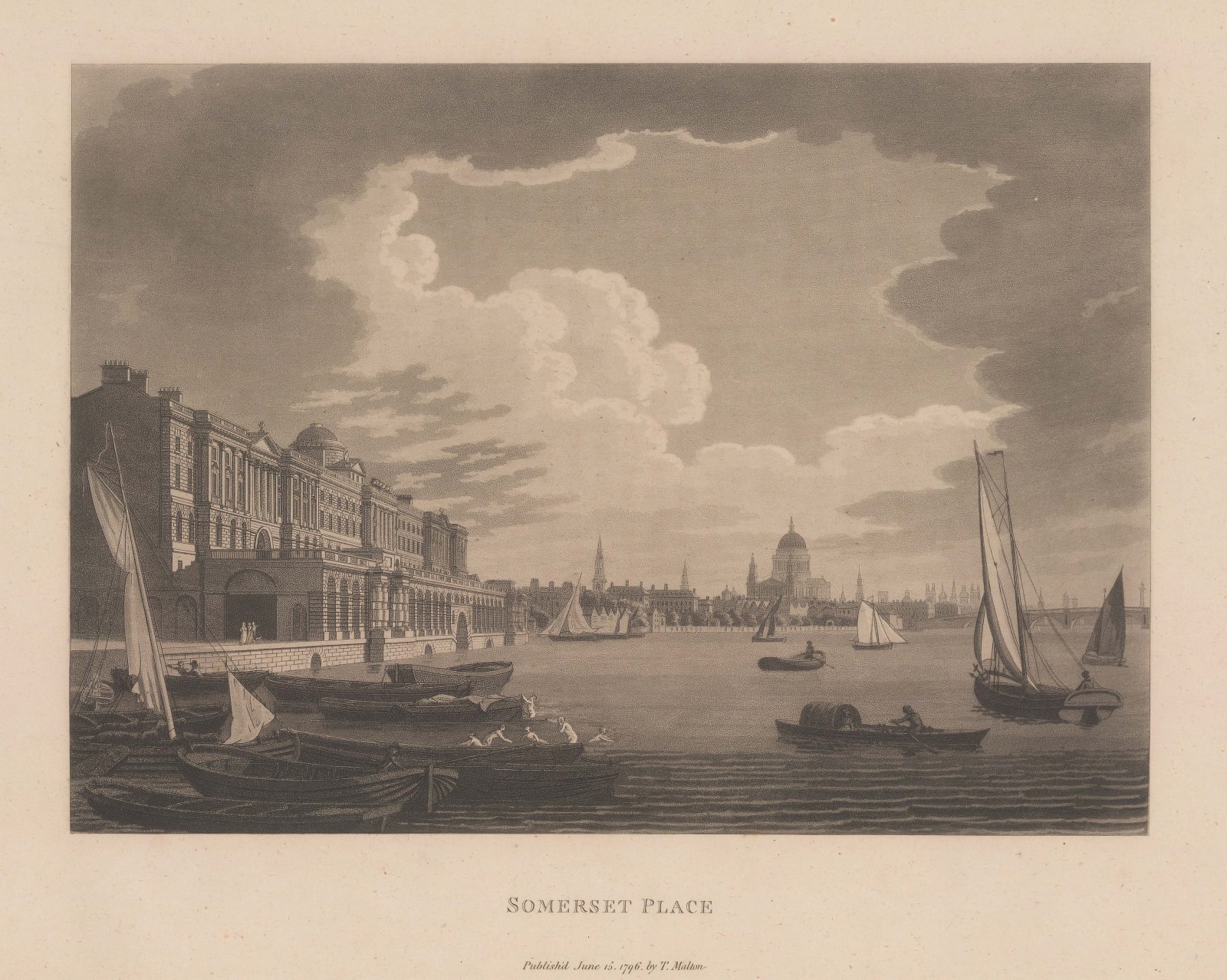Thomas Malton
London - Somerset House, 1800
An original antique aquatint
10 x 14 in
26 x 35 cm
26 x 35 cm
LDNp2981
Somerset Place: River scene with St Paul's. Son of Thomas Malton the Elder, a London architectural draughtsman and geometry scholar, Thomas Malton the Younger followed in his father's footsteps working...
Somerset Place: River scene with St Paul's.
Son of Thomas Malton the Elder, a London architectural draughtsman and geometry scholar, Thomas Malton the Younger followed in his father's footsteps working as his apprentice and then working under one of the leading architects of the time, James Gandon. Malton became a regular exhibitor at the Royal Academy, painted scenes for theatres and taught drawing but it is for his magnificent scenes of London that he is best remembered.
A Picturesque Tour through the Cities of London and Westminster is remarkable, if not unique, in that all the plates of which it is composed were engraved and aquatinted by the artist himself. The secret of the aquatint process which allowed for gentle gradations of tone similar to those of watercolour paintings was developed in France in 1768 by Jean Baptiste Le Prince and crossed the Channel in 1774. It was passed on to the landscape painter Paul Sandby who applied it to his 24 Views in Wales published in the three succeeding years. Malton's project was on an altogether larger scale as it was not only the first considerable collection of London views engraved in aquatint but also the first large British aquatint series on any topic.
Although the title of his work, A Picturesque Tour, suggests Malton's concern lay with presenting a restful image of the city, much of his work is characterised by plunging perspectives and vigorous architectural clarity - traits which he nurtured in his young pupil William Turner upon whom he had a considerable influence; many of Turner's watercolours relate quite closely to the subjects in Malton's Picturesque Tour.
Malton’s principal aim was accuracy, detail and to convey the sense of structures and as such A Picturesque Tour remains an essential albeit rare part of the dramatic record of the topographical history of London
Son of Thomas Malton the Elder, a London architectural draughtsman and geometry scholar, Thomas Malton the Younger followed in his father's footsteps working as his apprentice and then working under one of the leading architects of the time, James Gandon. Malton became a regular exhibitor at the Royal Academy, painted scenes for theatres and taught drawing but it is for his magnificent scenes of London that he is best remembered.
A Picturesque Tour through the Cities of London and Westminster is remarkable, if not unique, in that all the plates of which it is composed were engraved and aquatinted by the artist himself. The secret of the aquatint process which allowed for gentle gradations of tone similar to those of watercolour paintings was developed in France in 1768 by Jean Baptiste Le Prince and crossed the Channel in 1774. It was passed on to the landscape painter Paul Sandby who applied it to his 24 Views in Wales published in the three succeeding years. Malton's project was on an altogether larger scale as it was not only the first considerable collection of London views engraved in aquatint but also the first large British aquatint series on any topic.
Although the title of his work, A Picturesque Tour, suggests Malton's concern lay with presenting a restful image of the city, much of his work is characterised by plunging perspectives and vigorous architectural clarity - traits which he nurtured in his young pupil William Turner upon whom he had a considerable influence; many of Turner's watercolours relate quite closely to the subjects in Malton's Picturesque Tour.
Malton’s principal aim was accuracy, detail and to convey the sense of structures and as such A Picturesque Tour remains an essential albeit rare part of the dramatic record of the topographical history of London
Join our mailing list
* denotes required fields
We will process the personal data you have supplied to communicate with you in accordance with our Privacy Policy. You can unsubscribe or change your preferences at any time by clicking the link in our emails.


